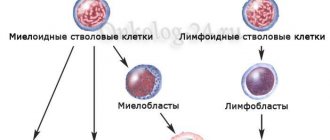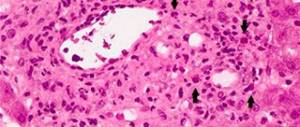Chronic myeloid leukemia in children
This type of cancer is not typical for young patients; the diagnosis rate is only 1-5% of clinical cases of all childhood leukemia.
This pathological condition can occur in a small child in one of two types:
- Juvenile (related to adolescence) chronic myeloid leukemia. This type of disease is considered “adult” and predominates in children after 5 years of age. A characteristic feature of this type of disease is the presence of the Philadelphia chromosome in the structure of leukocytes.
- Infantile (underdeveloped, childhood) myeloid leukemia. This type of disease mainly affects children under two years of age and differs from the juvenile form in the absence of an abnormal chromosome in the blast cells. Another characteristic feature of this type of disease is a pronounced decrease in the number of leukocytes in the blood in sick children already at an early stage of the development of the pathological condition, which leads to frequent bleeding, which is very difficult to stop.
Worth knowing! The younger the child, the more acute the disease. Most often, the childhood form of myeloid leukemia is incurable - the baby’s death occurs very quickly due to the early development of thrombocytopenia, leading to extensive internal bleeding, which is often impossible to stop.
The essence of pathology
Chronic myeloid leukemia (CML) is characterized by an increase in the blood levels of granulocytes, a type of white blood cell. Forming uncontrollably in the bone marrow, a significant part of them enters the blood immature. The concentration of other types of leukocytes decreases, and young, altered cells can reach maturity.
At the beginning of the development of pathology, the number of leukocytes is about 20,000/μl. As it progresses, this figure changes to 400,000/µl. Cells of varying degrees of maturity are found in the blood - immature (promyelocytes, myelocytes, metamyelocytes) and mature (band neutrophils).
Abnormalities in chromosomes are recorded. Most often, the disease provokes a noticeable increase in the concentration of other types of leukocytes (basophils and eosinophils). This is evidence of a severe form of CML. In patients, the spleen increases in size, and the number of myeloblasts (progenitors of granulocytes) increases in the bone marrow and blood.
Classification of chronic myeloid leukemia
Chronic myeloid leukemia in clinical practice is usually divided into stages depending on how mature the blood cells that make up the tumor structures are.
Read here: Lymph nodes in blood cancer
The development of chronic myeloid leukemia goes through 3 phases, each of which is characterized by certain clinical signs and morphological changes in the blood:
- The chronic phase or the onset of a pathological process. Chronic myeloid leukemia begins to develop gradually. First of all, myeloid proliferation occurs (proliferation of bone marrow tissue due to activation of blast cell division), which leads to the appearance of specific changes in the blood. There are no general clinical signs at this stage, so chronic myeloid leukemia at the beginning of its development is usually an incidental finding.
- Acceleration phase, or transition. At this stage, clinical symptoms are mild and the patient’s condition can be considered stable. Only histological signs undergo changes - the quantitative composition of leukocytes and myelocytes begins to increase.
- Terminal, final phase. The final stage of the disease is characterized by the appearance of pronounced clinical signs that are difficult to tolerate by patients. Their appearance indicates the onset of a blast crisis. One of the features of the disease, which is always accompanied by the final phase, is an infarction of the spleen and its obvious increase due to the accumulation of a large number of blast cells in the hematopoietic organ. In more than half of patients at this phase of the disease, fibrosis (tissue enlargement) of the bone marrow is detected.
Worth knowing! It is usually possible to detect chronic myeloid leukemia of the bone marrow, spleen and blood in the last phase of the disease, which is due to the absence of specific symptoms at stages 1 and 2. Such insidiousness of the disease leads to frequent deaths, but its slow development, which can last for many years, brightens up this picture, since in many patients it is possible to identify the pathological condition in the early phase, when diagnosing another disease.
Diagnostics
To make a diagnosis, the patient’s symptoms and the results of laboratory blood tests are assessed. A general blood test allows you to determine the amount of all types of elements. In chronic leukemia, there is an increased level of immature white cells and a decrease in the number of platelets and red blood cells. When conducting a biochemical analysis, signs of dysfunction of the spleen and liver are revealed due to the penetration of cancer cells into them.
Important information: What are the first symptoms (signs) of leukemia in children under one year of age and is it possible to cure a newborn child from leukemia
To confirm the diagnosis, a cytogenetic analysis is often prescribed, which allows one to examine the chromosome set and identify an anomaly. This method helps to accurately determine the type of leukemia. In addition, hybridization and polymerase chain reaction tests are often performed. A bone marrow biopsy may be performed. Additional tests used to assess the condition of internal organs include CT, MRI and ultrasound.
Reasons that provoke the development of blood pathologies
Chronic myeloid leukemia is the first and only cancer whose cause has been reliably established. The main prerequisite that provokes the onset of the disease is the appearance of an abnormal chromosome in the blast cells of the hematopoietic organs. The disease that arises as a result of such a genetic mutation develops very slowly, and a person can live into old age without learning about the presence of oncological pathology in his blood. But the development of chronic myeloid leukemia can also be rapid.
Read here: Treatment of brain tumors
The disease can quickly, within a few months, reach its final phase if there are certain risk factors in a person’s life, the main ones of which are considered to be:
- living in areas with increased background radiation or areas in close proximity to nuclear power plants;
- long-term treatment with cytostatics or uncontrolled use of antibacterial drugs that have increased toxicity;
- regular, long-term exposure to toxic and chemical substances on the human body;
- a person's history of Klinefelter or Down syndrome.
If at least one of these risk factors is present in a person’s life, he needs to be more attentive to his well-being and, if minimal health problems appear, consult a specialist for advice. Also, annual preventive diagnostics are recommended for people at risk. Timely detection of pathological changes in blood composition allows the developing chronic form of myeloid leukemia to be completely cured.
Causes of the disease
Certain genes control cell growth and division. Some stimulate the development process (oncogenes), others slow it down, causing physiological cell death (suppressors). Myeloid leukemia is caused by DNA mutations that promote the spread of oncogenes or “turn off” suppressors.
The cells of the human body contain 23 pairs of chromosomes. Typically, CML begins to develop when fragments are “exchanged” between chromosomes 9 and 22 (translocation). An abnormal gene is formed, and chromosome 22 decreases in size. A transformed chromosome, called the Philadelphia chromosome, is observed in the altered cells of almost all patients diagnosed with chronic myeloid leukemia. It is this that causes the growth and chaotic division of pathological cells.
In a small number of patients, the harmful cells do not contain the altered chromosome. It is believed that the affected gene is formed differently in them. It is extremely rare that patients do not have either an altered gene or a “broken” chromosome. It is assumed that in this case the development is provoked by unknown oncogenes.
Experts do not classify a chromosome defect as genetic, but studies have shown that there is a high probability of developing the pathology in children whose parents have some kind of genetic abnormality (Down syndrome). The occurrence of chronic myeloid leukemia is influenced by certain external factors:
- high doses of radiation exposure;
- negative effects of chemicals (alcohols, epoxy resins, alkenes, ketones, aldehydes);
- age (over 30 years);
- gender (more often the disease is diagnosed in men).
A weakened immune system may be a risk factor. Smoking contributes to a more severe course of the disease.
Symptoms of oncopathology of the hematopoietic organs
Signs of the disease are absent for a long time; the first specific symptoms of chronic myeloid leukemia, causing a person to become alarmed and visit a doctor, usually appear in the terminal stage of the disease, when it is impossible to cure it. The initial phase of the disease is characterized by vague, mild symptoms. But knowing them, you can suspect the development of a pathological condition and, by contacting a hemato-oncologist in a timely manner, diagnose chronic myeloid leukemia in an early phase that responds well to therapy.
The main signs that should raise alarm include:
- swollen lymph nodes;
- anemia, characterized by pale skin;
- constant feeling of malaise and fatigue;
- unreasonable loss of appetite and weight loss;
- the appearance of bruises and bruises on the skin;
- frequent and prolonged external or internal bleeding;
- feeling of fullness on the left side of the abdominal cavity due to an increase in the size of the spleen.
These symptoms are typical for many diseases, but their appearance cannot be ignored, because they may indirectly indicate a developing blood cancer. Often it is thanks to the patient’s complaints about the presence of these signs that a dangerous disease can be detected in a timely manner.
Types of therapy for chronic myeloid leukemia: medication, surgery, radiation
All therapeutic measures used to stop the oncological process that has affected the hematopoietic organs are prescribed by a hemato-oncologist based on the phase of development of the disease, general signs characterizing its course and the severity of the clinical picture accompanying chronic myeloid leukemia.
Therapeutic measures are prescribed individually to each patient, depending on the stage of the disease:
- In the initial, chronic phase, no special treatment is required. To maintain a stable condition in patients, they are prescribed general restorative therapy, which consists of correcting nutrition, reducing physical activity and observing a work-rest regime.
- The activation phase of chronic myeloid leukemia requires expansion of therapeutic measures. Patients are required to undergo courses of biological therapy with Interferon and chemistry with Chloroethylaminouracil, Hexaphosphamide or Mitobronitol. If indicated, a bone marrow transplant may be prescribed.
- When a blast crisis occurs, treatment becomes useless. At this final phase of the disease, patients receive exclusively symptomatic therapy to alleviate the painful symptoms of the disease and maintain quality of life until the last days.
Types of myelocytic leukemia
The differences in types and forms lie in the nature of the clinical course and the predominant type of accumulated cells.
According to the flow there are:
- acute form;
- chronic myeloid leukemia.
In the chronic course, not only is there a slow development of the symptoms of the disease, but also a special shift is detected in the blood, which is not characteristic of the acute form. Therefore, unlike somatic diseases, the transition from acute to chronic is impossible.
Acute myeloid leukemia, according to the WHO classification, is divided into types depending on the identified effects of different chromosome regions.
Another current classification, approved by hematologists in the USA, France and Great Britain, takes into account 9 subtypes according to the degree of maturity of leukocytes. The allocation makes sense not only scientifically, but also assumes the same optimal standard therapy. These are classified according to the degree of cell maturation:
- leukemia without maturation;
- with maturation;
- with minimal differentiation of cellular composition.
According to the predominant composition of cellular forms:
- promyelocytic leukemia;
- myelomonocytic - accumulation of cells, precursors of monocytes and granulocytes;
- myelomonocytic in combination with eosinophilia;
- myelomonoblastic leukemia - monoblasts make up the majority of clones;
- megakaryoblastic;
- basophilic;
- group of erythroid leukemias.
Chronic myelomonocytic leukemia also consists of several types of progenitor cells:
- myelocytic leukemia with and without the Philadelphia chromosome;
- juvenile myelomonocytic leukemia;
- neutrophilic and eosinophilic species;
- primary myelofibrosis.
Prognosis for recovery
It is possible to stop developing chronic myeloid leukemia only at the initial stage of the pathological process, provided that the treatment is carried out correctly. But this happens very rarely, since timely detection of the disease presents serious difficulties. Most patients die in the transition or terminal phase of chronic myeloid leukemia. From diagnosis of the disease to death at these stages of the disease, it takes about two years. Of particular danger is the onset of blast crisis - during this phase, cancer patients live no longer than six months. The most unfavorable is the presence of an abnormal Philadelphia chromosome in the blood genes.
Prevention of myeloid leukemia
There are currently no specific preventive measures to prevent chronic myeloid leukemia. The only thing hemato-oncologists advise people who are at risk for developing an oncological process in the hematopoietic organs is regular screening tests.
General recommendations for the prevention of chronic myeloid leukemia include:
- correction of the diet with the inclusion in the daily menu of dishes enriched with vitamin and mineral complexes;
- complete cessation of addictions (smoking, alcohol abuse, evening overeating), or reducing them to a minimum;
- maintaining an active, healthy lifestyle with regular participation in feasible sports;
- Reducing exposure to ultraviolet radiation: avoiding exposure to direct sunlight.
Pathology therapy
Therapy for chronic myeloid leukemia is determined by the stage of the pathology. At an early stage, restorative treatment, a balanced diet enriched with vitamins, and regular medical check-ups are recommended. In other cases, CML is treated with medications that help reduce the size of the spleen and reduce the activity of malignant cells. The patient’s life expectancy directly depends on the adequacy and timeliness of the therapy. Therapy is carried out using several methods:
- Drug treatment (Cytosar, Alpha interferon, Myelosan);
- Bone marrow transplantation (the likelihood of recovery is higher during surgery in the early stages of the pathology; preferred donors are the patient’s relatives);
- Radiation therapy (the goal is to destroy malignant cells and reduce the rate of their development);
- Removal of the spleen (usually at the last stage of pathology). Indications for surgical intervention may include thrombocytopenia, the threat of damage to the spleen, and obvious discomfort caused by the size of the organ.
If taking medications does not give the expected effect, leukophoresis is used - cellular cleansing of the blood from an excessive number of leukocytes. Sometimes it is used in parallel with drug treatment. A significantly enlarged spleen is sometimes exposed to x-rays, this helps to reduce its size. When purulent inflammatory foci occur, antibiotics are used.
With the development of severe anemia tolerant to cytostatics, or when treating iron deficiency anemia with appropriate iron preparations, blood transfusion is indicated. Patients are subject to registration at the dispensary; they need regular examinations and monitoring of blood counts. Independent therapy for the chronic form of myeloid leukemia is untenable and unacceptable.
Pathology progression
With the development of pathology, cytostatics are indicated. The extent of treatment depends on the phase of the disease. The occurrence of obvious symptoms (enlargement of organs, increase in the number of leukocytes in comparison with an earlier stage of pathology) is a reason for the use of primary restraining approaches. Patients are prescribed hydroxyurea in small doses on an outpatient basis, subject to monitoring blood counts. After remission of the disease, maintenance treatment is used.
Advanced stage of pathology
If the disease has reached an advanced stage, drug treatment is carried out depending on the “risk group” (hematological indicators). If the risks are low, treatment is initially carried out with one drug (monochemotherapy); if the risk is high, it is immediately recommended to use several drugs simultaneously (polychemotherapy).
Having completed the course of monochemotherapy, the same drug is first prescribed, but in a higher dosage. If blood counts improve, it is discontinued or the dosage is reduced. If the cytostatic used does not bring the expected effect within a month, treatment is carried out with another drug.
After a course of chemotherapy, maintenance treatment is carried out (the scheme is similar to the scheme of primary restraining therapy). Medicines that have proven effective during a course of treatment are used. Polychemotherapy is carried out at an increased degree of risk and at the last stage of CML. For blast crisis, therapy is similar to the treatment of acute leukemia. Polychemotherapy is carried out in short courses of 5-14 days. The duration of the breaks is 7-10 days.
Alpha interferon
Fundamentally new treatments for chronic myeloid leukemia include alpha-interferon, a growth factor antagonist. It inhibits the influence of megakaryocytes on the process of hematopoiesis and prevents the proliferation of granulocytes. In addition, alpha interferon activates antitumor immunity, creating conditions for the normalization of hematopoiesis.
Being a cytostatic, the drug does not have a depressive effect on healthy cells. Treatment with alpha interferon can also cause cytogenetic remission - the absence of the Philadelphia chromosome. This does not even indicate remission, but the complete recovery of the patient.
There are no preventive measures for chronic myeloid leukemia. It is only possible to prevent exacerbations of pathology (maintenance treatment, prevention of insolation, colds). The average life expectancy for CML is three to five years, sometimes up to eight. After the development of blast crisis, the patient rarely manages to live more than a year.











